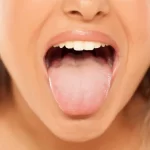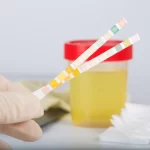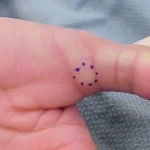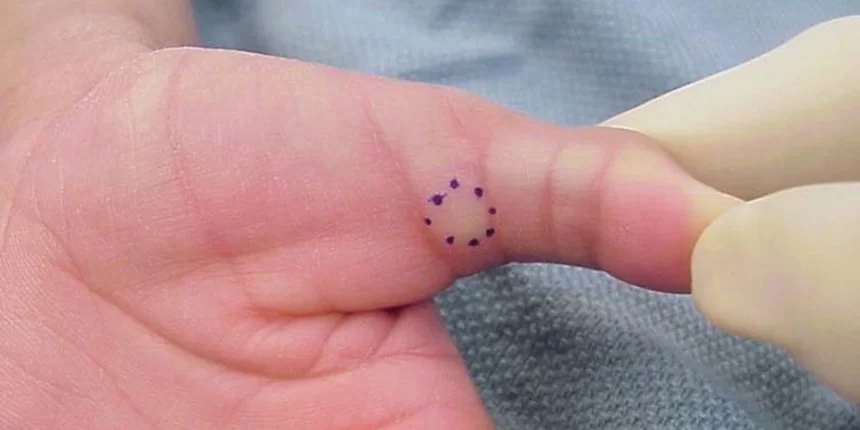I would like you to look at your son with different eyes. Check your thumb, and learn how to diagnose a child’s trigger finger or thumb.
Have you seen the cover image? That baby could have a hooked thumb and an infant trigger finger.
No need to be alarmist. However, this pretty photo features a flexed thumb. If all the fingers do not extend once the hand relaxes, then an infantile trigger finger appears.
Who diagnoses a childhood trigger finger?
Parents of infants report to the pediatrician that they see something unusual on the thumb.
Pediatricians make the diagnosis of visu—no additional tests.
Sometimes the diagnosis of the trigger finger is delayed. Moreover, the nursery school teacher or teacher objectifies something strange when making the clamp to take the pencil or the colours.
Anyone who is a keen observer can diagnose a trigger finger.
Were they? Child trigger finger or trigger thumb?
Children’s trigger finger. Note the flexed position of the thumb.
Why is that?
Because of the regular use of the clamp, picking up something between the thumb and index finger is an acquired habit that takes hold during the first and second years of life.
If during that time it appears, the finger is hooked. The child may learn to do the clamp wrongly.
Sometimes children come to my consultation at five or six years with their fingers flexed. These children have never “stretched” their fingers.
Then an excruciating physiotherapy job is necessary to reeducate those fingers and that clamp…
Symptoms of a trigger thumb?
Trigger thumb. Note that it is impossible to stretch the finger.
I will explain. When a baby is born, its musculoskeletal system is immature. It is born rigid -so you understand me-. Moreover, the upper extremities and then the legs relax little by little.
By that, I mean do not get confused; newborn babies have very flexed fingers, but little or little, they relax the structures. You have to pay attention to his fingers.
If you want to learn more about the subject, you should read this great post by my friend and doctor, María José Mas Salguero, neuro pediatrician. A post about motor development in children.
Pediatric trigger finger treatment.
Trigger finger, preoperative profile photo. Look at the angle marked in red, which is the space the finger CAN NOT go through because the tendon is stuck.
Trigger finger, preoperative frontal photo. The drawing is to point the finger before surgery and lower the child’s anxiety level. The arrow indicates the place where the stuck area exists and is the area where the “tendon sheath” will open.
Trigger finger, preoperative frontal photo. The drawing is to point the finger before surgery and lower the child’s anxiety level. The arrow indicates the place where the stuck area exists, and it is the area where the “tendon sheath” will open.
Rehabilitation and physiotherapy have a significant role in mild cases where the finger is not stuck.
Sometimes the use of a splint may be necessary. However, they are such baby children that any device will be difficult to handle.
In straightforward cases of a hooked finger, the solution will be surgical.
You can read more here about the treatment of childhood trigger fingers.
Trigger finger surgery
This surgery requires anesthesia in general.
It is a non-aggressive surgical act that consists of making an opening to the pulley or sheath that holds the tendon.
It requires the placement of a couple or three points on the skin. Those points can fall alone or will be removed in consultations.
While the child has stitches, the ideal is not to wet the bandage.
The best of surgery for children: the postoperative period.
Perhaps they may be a little upset, no more than if they have hit themselves on the forehead and required a couple of stitches.
They calm down with the usual doses of Paracetamol and Ibuprofen.
The best: playing with the thumb that no longer hooks.
Drawing of the surgical experience of a girl operated on for a trigger finger. They all smile. We are doing something right!
Drawing of the surgical experience of a girl operated on for a trigger finger. They all smile. We are doing something right!Once the infant has been operated on, you find worried parents, uncles and grandparents in the room. They “riddle” you with questions, and you answer them one after another. (But since you are a mom, you understand them and their concern…)
Then comes the best, to those uncles or grandparents, I send them to buy a toy with small parts adapted to the child’s age. Books with textures or construction toys that start with L…
Moreover, when I am going to give the final hospital discharge, I find myself a child happier than Easter, playing with a new toy next to his whole family.
A child, a whole. Many specialties with the same objective. Your child’s health.
I already explained it in a post about the early diagnosis of childhood scoliosis. Each one observes what he is used to observing in his day-to-day.
Imagine your poor pediatrician. Thirty-five children in the consultation plus four emergencies: fever or not. Observe all the skin that a petechia does not escape (small spots sometimes accompanied by meningitis….) How he breathes, coughs, and auscultation of the heart and lungs. Do you hear a heart murmur? Is your snot green or not? His poop, feel his gut. Breastfeeding or not. Does not tolerate milk, fourth change of artificial milk. Sleep at night. Night terrors? Developmental achievements, if he already sits, crawls, walks with ten months, first words. Yes, nursery, diaper, yes diaper, no. Connect with the mother, with me—jealousy with younger siblings. Divorced families, reconstituted families, the father’s girlfriend comes, the stepfather comes.

















Add Comment